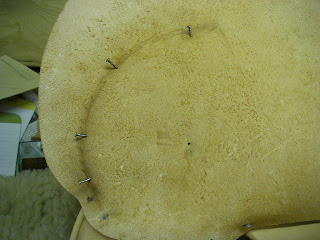
Wednesday, January 31, 2007
oiling

cantle bind


inlaid seat
Saturday, January 27, 2007
small parts
lining skirts


Friday, January 26, 2007
horn

fenders and leathers

fitting seat
6;the seat is spiked in place and the drawdown stand is used to get the seat as tight as possible on the saddle. The spikes are removed and the seat temporarily screwed into place and left to dry. once the seat is dry the inlaid padded seat will be fit and then the seat will be glued into place and the cantle will be sewn.
5;Then the drawdown stand is used again to fit the top seat to the ground seat,
4;The double line border is cut in, if the seat was stamped this is when that would be done. When stamping the seat you must take the shape out of the seat so it can be laid flat on the stamping bench, once you have finished stamping the seat, it must be shaped again to fit the contours of the saddle, as you can see in the photo below the seat is not shaped to fit the ground seat yet. The next couple photos above will show a brief look at the process of shaping the seat with the drawdown stand.

3;the seat is spiked on and the rest of the seat is fit. This is not done by using a set pattern, each seat must be fit to each individual saddle.

2;the ears are fit

1;the ruff seat leather

Howdy;
here are some of the steps to fitting a seat.
Monday, January 22, 2007
Sunday, January 21, 2007
skirts and jockeys




cantle filler




ground seat







Friday, January 12, 2007
riggins



Thursday, January 11, 2007

first post
If you would like to have a look at my online photo album click on this link
http://ca.pg.photos.yahoo.com/ph/flynsaddle/my_photos










